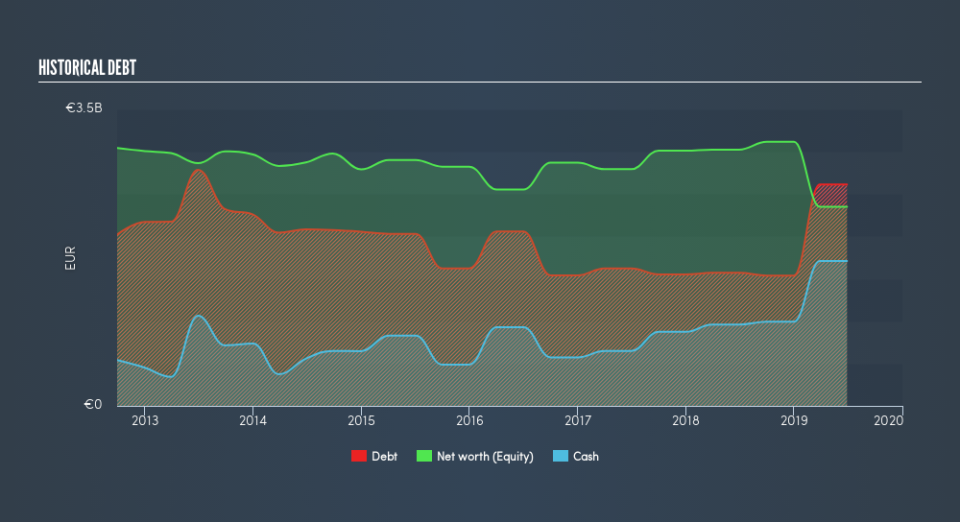Is Coca-Cola HBC (LON:CCH) Using Too Much Debt?

The external fund manager backed by Berkshire Hathaway's Charlie Munger, Li Lu, makes no bones about it when he says 'The biggest investment risk is not the volatility of prices, but whether you will suffer a permanent loss of capital.' When we think about how risky a company is, we always like to look at its use of debt, since debt overload can lead to ruin. We note that Coca-Cola HBC AG (LON:CCH) does have debt on its balance sheet. But the more important question is: how much risk is that debt creating?
When Is Debt Dangerous?
Debt is a tool to help businesses grow, but if a business is incapable of paying off its lenders, then it exists at their mercy. Part and parcel of capitalism is the process of 'creative destruction' where failed businesses are mercilessly liquidated by their bankers. While that is not too common, we often do see indebted companies permanently diluting shareholders because lenders force them to raise capital at a distressed price. By replacing dilution, though, debt can be an extremely good tool for businesses that need capital to invest in growth at high rates of return. The first thing to do when considering how much debt a business uses is to look at its cash and debt together.
Check out our latest analysis for Coca-Cola HBC
How Much Debt Does Coca-Cola HBC Carry?
As you can see below, at the end of June 2019, Coca-Cola HBC had €2.61b of debt, up from €1.57b a year ago. Click the image for more detail. However, it also had €1.71b in cash, and so its net debt is €904.7m.
How Strong Is Coca-Cola HBC's Balance Sheet?
We can see from the most recent balance sheet that Coca-Cola HBC had liabilities of €3.88b falling due within a year, and liabilities of €2.36b due beyond that. Offsetting this, it had €1.71b in cash and €1.31b in receivables that were due within 12 months. So its liabilities total €3.22b more than the combination of its cash and short-term receivables.
This deficit isn't so bad because Coca-Cola HBC is worth a massive €10.9b, and thus could probably raise enough capital to shore up its balance sheet, if the need arose. But we definitely want to keep our eyes open to indications that its debt is bringing too much risk.
In order to size up a company's debt relative to its earnings, we calculate its net debt divided by its earnings before interest, tax, depreciation, and amortization (EBITDA) and its earnings before interest and tax (EBIT) divided by its interest expense (its interest cover). Thus we consider debt relative to earnings both with and without depreciation and amortization expenses.
Coca-Cola HBC has a low net debt to EBITDA ratio of only 0.88. And its EBIT covers its interest expense a whopping 12.7 times over. So you could argue it is no more threatened by its debt than an elephant is by a mouse. The good news is that Coca-Cola HBC has increased its EBIT by 6.1% over twelve months, which should ease any concerns about debt repayment. When analysing debt levels, the balance sheet is the obvious place to start. But ultimately the future profitability of the business will decide if Coca-Cola HBC can strengthen its balance sheet over time. So if you want to see what the professionals think, you might find this free report on analyst profit forecasts to be interesting.
But our final consideration is also important, because a company cannot pay debt with paper profits; it needs cold hard cash. So we always check how much of that EBIT is translated into free cash flow. Over the most recent three years, Coca-Cola HBC recorded free cash flow worth 54% of its EBIT, which is around normal, given free cash flow excludes interest and tax. This free cash flow puts the company in a good position to pay down debt, when appropriate.
Our View
Happily, Coca-Cola HBC's impressive interest cover implies it has the upper hand on its debt. And we also thought its net debt to EBITDA was a positive. All these things considered, it appears that Coca-Cola HBC can comfortably handle its current debt levels. Of course, while this leverage can enhance returns on equity, it does bring more risk, so it's worth keeping an eye on this one. Over time, share prices tend to follow earnings per share, so if you're interested in Coca-Cola HBC, you may well want to click here to check an interactive graph of its earnings per share history.
At the end of the day, it's often better to focus on companies that are free from net debt. You can access our special list of such companies (all with a track record of profit growth). It's free.
We aim to bring you long-term focused research analysis driven by fundamental data. Note that our analysis may not factor in the latest price-sensitive company announcements or qualitative material.
If you spot an error that warrants correction, please contact the editor at editorial-team@simplywallst.com. This article by Simply Wall St is general in nature. It does not constitute a recommendation to buy or sell any stock, and does not take account of your objectives, or your financial situation. Simply Wall St has no position in the stocks mentioned. Thank you for reading.

 Yahoo Finance
Yahoo Finance 
